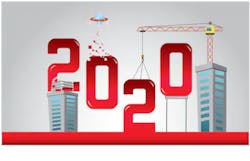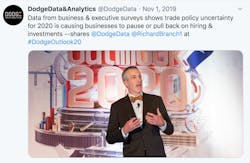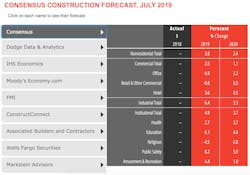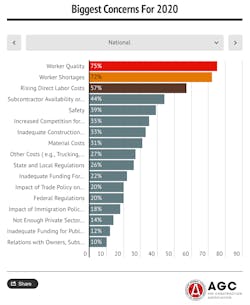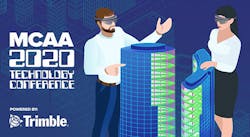Gazing Ahead, 2020 Vision Not Quite Perfect
DESPITE CONTINUING SIGNS of economic strength at the outset of 2020, there is a palpable sense of uneasiness among industry experts and market analysts about how much longer the good times can last. Indeed, any economic surge that has been growing for more than a decade seems like it must be nearing an end, but at press time, prospects remained relatively good, tempered by new fears of war in the Middle East and related spikes in oil prices.
Still, for the foreseeable future, the optimism reflected in the recent AHR Expo Survey of 2020 Attendees is still prevalent in many other quarters of the industry.
“Within the new construction market, we see continued strength for new-build projects and further growth in energy retrofit projects as building owners take advantage of savings opportunities and utility rebates,” said Steven Lane, communications manager at Toronto-based Armstrong Fluid Technology, a manufacturer of demand-controlled fluid flow and heat transfer equipment, emphasizing energy efficiency and sustainability.
“Overall, we see our related markets in 2020 starting to pull back a little bit, but they will remain generally positive throughout the year,” adds Matthew McBurney, VP of HVAC and corporate strategy at Modine Manufacturing Co., Racine WI. “Within that, we expect to see stronger growth in key segment areas around schools and data centers, as the macro trends should remain stable.”
Even the more pessimistic voices going into this year were not predicting any dire turn of events. Indeed, one expert notes, mechanical contractors typically have a backlog of one to two years of work in the pipeline. So there should be a relatively soft landing if and when a downturn arrives.
“There are some absolutes in life; one is that downturns in the economy are inevitable and another is that economic recoveries and growth follow,” said Alan Beaulieu, president of ITR Economics, and this month’s keynote speaker at the American Boiler Manufacturers Association annual meeting in San Diego.
“We don’t see a recession happening in 2020,” noted Richard Branch, chief economist at Dodge Data & Analytics, New York. “A slowdown, yes. A recession, no.”
Branch made his remarks at Dodge Data’s ‘Outlook 2020’ Conference for the Construction Industry, held Oct. 31 in Chicago. There, he unveiled the group’s latest annual forecast, which predicts a 4% decline in total U.S. construction starts in 2020 to a total of $776 billion. That total includes an expected 6% drop in commercial building starts. “The recovery that began during 2010 in the aftermath of the Great Recession is coming to an end,” he explained. “Easing economic growth driven by mounting trade tensions and lack of skilled labor will lead to a broad-based, but orderly pullback in construction starts in 2020.”
Indeed, the tightening labor market comes up often in discussing business prospects for this year. On Jan. 4, Uponor North America President Bill Gray told the Minneapolis Star-Tribune: “One issue in the workforce is aging. Another is that the workers we are trying to attract are skilled and semi-skilled, which is a very narrow band.” So Uponor has tried to combat those trends “by having attractive wages and benefits and total compensation [because] people have more choices (now) and will pick what works best for them,” added Gray. Even so, he conceded that there is also a general “skittishness” about the health of the market, “not necessarily in 2020, but in 2021.” That skittishness is common.
“The uncertainty surrounding the overall health of the economy is leading developers to proceed with more caution on new projects,” said Kermit Baker, chief economist at the American Institute of Architects (AIA), in remarks made Dec. 19. ”We are at a point where there is a potential for an upside but also a potential for things to get worse.”
Last July, AIA released its own Consensus Construction Forecast, which it will not update until later this month. Combining eight separate industry forecasts (see chart), the consensus then foresaw an overall increase of 2.4% in nonresidential construction contracts in 2020, led by a combined 4.4% uptick in school projects.
Similarly, Associated General Contractors of America (AGC) and Sage Construction and Real Estate last month released the results of their latest collaboration, The 2020 Construction Hiring and Business Outlook Report. Based on responses from nearly 1,000 member firms nationwide, the report again found both optimism and anxiety.
“Contractors are very optimistic about demand for construction in 2020,” said AGC CEO Stephen E. Sandherr. “At the same time, many construction executives are troubled by labor shortages and the impacts those shortages are having on operations, training and safety programs, and bottom lines.”
Still, 75% of the respondents said they planned to add staff in 2020 to keep pace with growing demand. But many expect it will be harder to hire. As a result, labor shortages are having an impact on construction costs and project schedules, AGC officials noted. More firms are increasing pay and expanding benefits to attract more qualified workers. Meanwhile, they are also investing more in training programs for current and new employees.
“Firms are adopting a variety of approaches to replace workers or allow for use of workers with less experience or training than before,” said AGC Chief Economist Ken Simonson, the association’s chief economist. As a result, he noted that nearly a third of respondents are investing in labor-saving equipment, including drones, robots and 3-D printers, to compensate for understaffing.
Toward that end, 46% of firms said they would increase their information technology (IT) investments in 2020. However, as more continue to invest in software for project management, document management, and fleet tracking/management, 43% conceded that they lack the time needed to implement and train employees on new systems.
“We’re seeing an increasing number of firms embrace technology, especially mobile technologies in the field, as a way to help increase efficiencies and achieve business objectives,” said Sage VP Dustin Anderson. “Technology will continue to play an important role in bridging the gap between growing industry demand, more complex projects, and a less experienced workforce.”
CAN LABOR-SAVING TECH SAVE THE DAY?
That sentiment echoes broadly across the industry, and it has only grown louder in recent years. Though some still fear the next recession will cause retreats in tech spending, others believe the labor-saving uses already have justified the costs.
“Insights into operations will help with identifying the sources and causes of inefficiencies,” noted Armstrong FT’s Lane. “Taking a ‘continuous improvement’ approach, building owners and operators will be able to optimize systems over time and find even greater cost savings.”
So, the growing need for tech interoperability between facility managers and the building automation systems (BAS) may be what forces contractors and engineers to upgrade their own capabilities, as well.
“As Internet of Things (IoT) technologies become more prevalent in buildings, the concept of a digital twin (a cyber-model or “avatar” of physical assets, processes, and systems) is expected to revolutionize the way facility managers analyze data to understand how their sites operate,” said Himanshu Khurana, chief technology officer at Honeywell Building Solutions, Golden Valley MN.
Added Sean McGuire, director of technology innovation at the Mechanical Contractors Association of America (MCAA), “Investment in technology in our industry is still low, but it is improving. And more trade associations are hiring tech executives to help lead those efforts, so I am not a lone wolf anymore,” he laughed.
Equipment advances are coming to the job site soon, McGuire added, saying he is excited by what he sees on the near horizon. Many examples, including a new and improved Microsoft HoleLens 2, fully integrated into a Trimble XR10, “smart” hardhat, will be presented this month at MCAA’s 2020 Technology Conference in San Diego. “The (250-person) event is sold out, and every year, we have more contractors presenting than manufacturers,” he noted, clearly pleased.
SUSTAINING SUSTAINABILITY GROWTH
One industry trend that continues to pulse through all other market factors is the continuing drive for sustainability and energy efficiency. And those goals continue to spur investment and innovation among competing manufacturers.
“The movement toward more-sustainable, all-electric technology remains on track and shows no signs of stopping,” said Mark Kuntz, CEO, Mitsubishi Electric Trane HVAC US, Sewanee GA. “Economic prospects continue to look strong for our industry as there’s greater customer demand for energy-efficient heating and cooling and broader appreciation for how heat pumps improve both comfort and sustainability.”
Noting broader urban trends, he added, “We’ll see more mainstream attention given to strategic electrification and how modern heat pumps make it feasible. Major cities nationwide, like Berkeley CA, have already begun to implement larger initiatives to significantly cut greenhouse emissions and meet rigorous decarbonization goals.”
With those goals in mind, “owner and occupant expectations for buildings have never been higher,” said Mark Verheyden, president of Honeywell Building Solutions. “In 2020, we will see smarter, greener, safer buildings that are more comfortable and cost-efficient. To achieve this, more buildings will be run by a central operating system that analyzes data in real-time and considers the building’s unique variables in order to identify the best way to function – balancing efficiency and comfort.”
In short, the future will arrive in 2020. But it remains to be seen how softly the economy will land and when. Wise firms had best plan accordingly.
